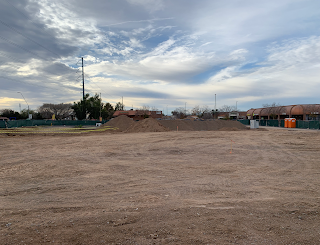Where the money in Phoenix comes from
I was talking to some friends of mine recently, and the subject of my interest in Phoenix history came up. And the question that seemed to be the most puzzling is where did the money come from? And what supports the wealth of Phoenix today?
Many people who went to school in Arizona know about the five Cs - Copper, Cotton, Cattle, Citrus, Climate. And yes, that's where the money for Arizona came from, but the money for Phoenix came from handling that money.
Phoenix grew around banks. As the money poured in from all over Arizona, Phoenix specialized in investment. Yes, there were banks, and investment companies elsewhere in Arizona, but nothing like Phoenix. Men like Dwight Heard, who founded the Suburban Land Company in 1897, and Walter Bimson, who took over Valley National Bank in 1933, helped Phoenix to explode with success.
Nowadays, of the five Cs, only climate really remains as a foundation of the Phoenix economy. Climate means tourism, but I guess they needed a word with a C, so they didn't say "Snow Birds". And if you're wondering what drives the economy of Phoenix today, it's climate. The climate of the winter, that is, when people from the cold parts of the country visit to play golf, etc.
Copper had been an unimportant part of mining in Arizona, after gold and silver, until a new process was introduced by John Greenway. And as the demand for copper skyrocketed during World War I, Arizona, and Phoenix, prospered. And that money went into the banks, and was reinvested.
And although we think of cotton as being used mainly for T-shirts, when Arizona was adding cotton to its list of what was making Arizona rich, it was because of a new invention, the automobile, which had an incredible thirst for tires, of which Egyptian cotton, grown in Arizona, was the best. Yes, cotton was essential to make car tires then.
If you look at old photos of Phoenix, especially around the Camelback Mountain area, you will see orange groves. Phoenix had the right climate for citrus, and something no other city in Arizona had, a steady supply of water from the Salt River. And oranges weren't the only citrus grown in Phoenix, there were grapefruits, lemons, etc.
And cattle isn't just the stuff of Old West history. There are people in Phoenix today who remember the gigantic stockyard at Washington and 50th Street. There is a restaurant by that name now, but that's all that remains.
I'm a booster for Phoenix. I worked for Valley National Bank, and Bank One. And it taught me the progressive spirit of Phoenix. And the more I learn about Phoenix, the more I learn about that spirit of being “unrealistically optimistic”. And if you take a look at Phoenix today, you will see that spirit of progress continues. And it never ceases to amaze me.
 |
| The Valley National Bank sign in 1957, downtown Phoenix |
 |
| At the Biltmore Golf Course in the 1950s, Phoenix, Arizona. |
 |
| 1917 ad for Goodyear Cotton |
 |
| Camelback Mountain in 1956, Phoenix, Arizona. |
Become a PhD (Phoenix History Detective) with Brad today on Patreon!
Click here to become a Patron!
History Adventuring posts are shared there daily including "then and now" photos, billboards, aerials, videos, and super high-definition photos of historic Phoenix, Arizona. Discounts for seniors, students, teachers, and veterans.




Comments
Post a Comment